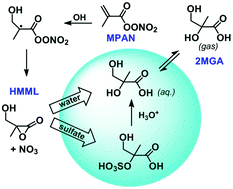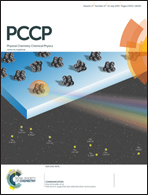Mechanism of the hydroxyl radical oxidation of methacryloyl peroxynitrate (MPAN) and its pathway toward secondary organic aerosol formation in the atmosphere†
Abstract
Methacryloyl peroxynitrate (MPAN), the acyl peroxynitrate of methacrolein, has been suggested to be an important secondary organic aerosol (SOA) precursor from isoprene oxidation. Yet, the mechanism by which MPAN produces SOA through reaction with the hydroxyl radical (OH) is unclear. We systematically evaluate three proposed mechanisms in controlled chamber experiments and provide the first experimental support for the theoretically-predicted lactone formation pathway from the MPAN + OH reaction, producing hydroxymethyl-methyl-α-lactone (HMML). The decomposition of the MPAN–OH adduct yields HMML + NO3 (∼75%) and hydroxyacetone + CO + NO3 (∼25%), out-competing its reaction with atmospheric oxygen. The production of other proposed SOA precursors, e.g., methacrylic acid epoxide (MAE), from MPAN and methacrolein are negligible (<2%). Furthermore, we show that the beta-alkenyl moiety of MPAN is critical for lactone formation. Alkyl radicals formed cold via H-abstraction by OH do not decompose to HMML, even if they are structurally identical to the MPAN–OH adduct. The SOA formation from HMML, from polyaddition of the lactone to organic compounds at the particle interface or in the condensed phase, is close to unity under dry conditions. However, the SOA yield is sensitive to particle liquid water and solvated ions. In hydrated inorganic particles, HMML reacts primarily with H2O to produce the monomeric 2-methylglyceric acid (2MGA) or with aqueous sulfate and nitrate to produce the associated organosulfate and organonitrate, respectively. 2MGA, a tracer for isoprene SOA, is semivolatile and its accommodation in aerosol water decreases with decreasing pH. Conditions that enhance the production of neutral 2MGA suppress SOA mass from the HMML channel. Considering the liquid water content and pH ranges of ambient particles, 2MGA will exist largely as a gaseous compound in some parts of the atmosphere.


 Please wait while we load your content...
Please wait while we load your content...